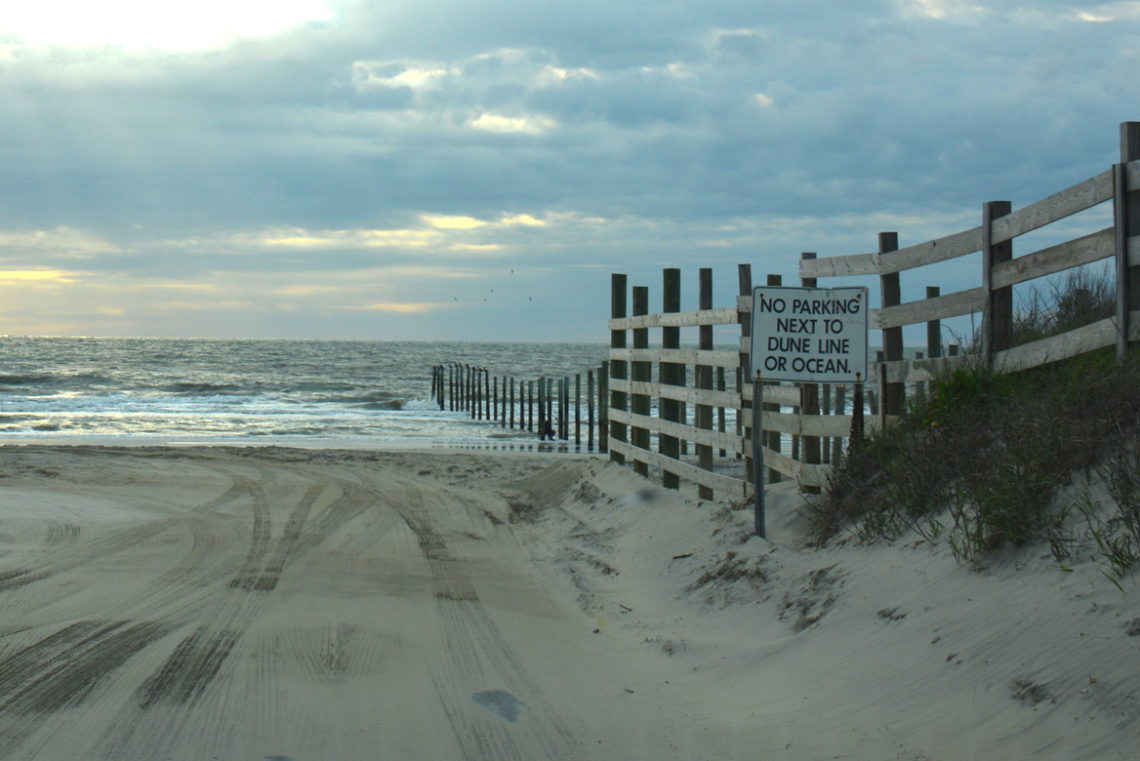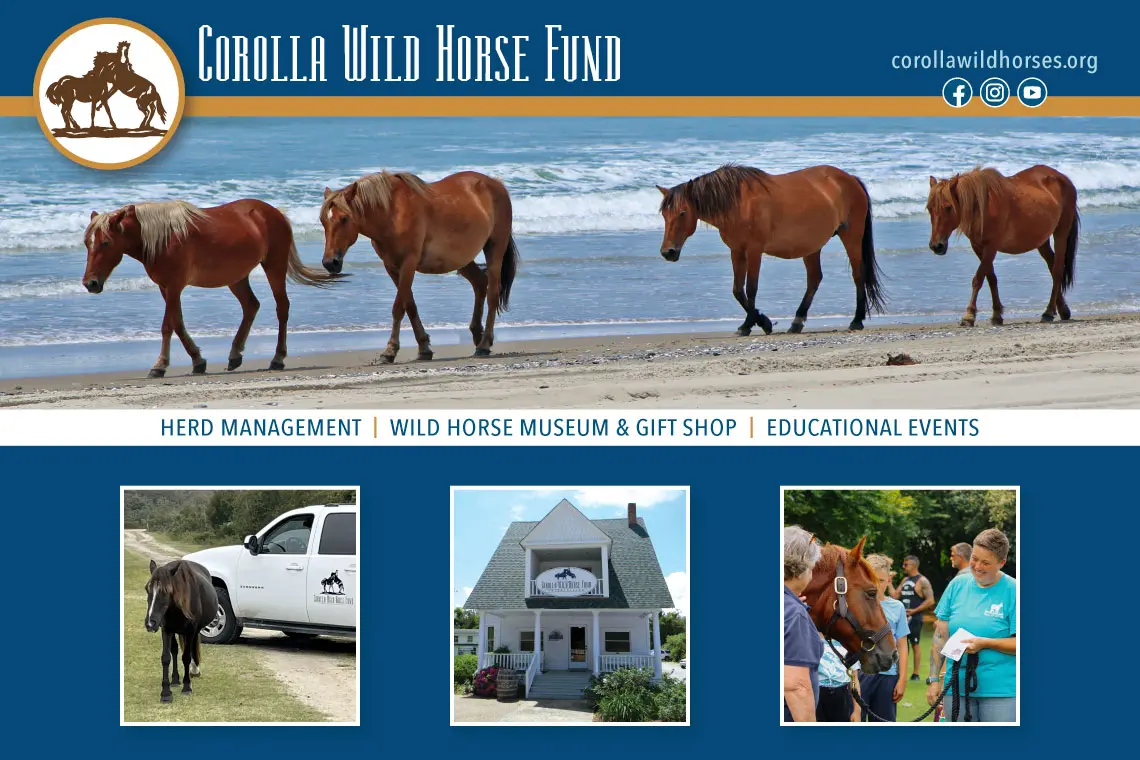Carova's history is unique along the Outer Banks. The 4WD region was one of the first areas of North Carolina to be explored by European settlers, but remained one of the least developed regions during the centuries that followed.
Facts
Historians estimate that Spanish ships began cruising past the northern Currituck Banks as early as the late 1400s, and set foot on the barrier island coastline in the 1500s. This presence led directly to the establishment of the famed Corolla Wild Horses, as many experts believe that the herd was either left behind during an ill-fated settlement attempt led by Spanish explorer Lucas Vasquez de Allyon, and / or were thrown overboard during treacherous sailing conditions.
Regardless of their exact roots, the wild horses survived and thrived in the centuries that followed, with a population of hundreds of wild horses recorded over the years.
In fact, the wild horse population was arguably larger than the local human population for much of the Currituck Banks' early years. Hardy settlers first started appearing along the Northern Outer Banks shoreline as early as the 1660s, but the population rarely grew over the next several centuries.
The Carova region finally experienced a minor boost during the mid-1800s, however, when five Lifesaving Service Stations were established to guide and assist mariners travelling offshore, and the 1876 Currituck Beach Lighthouse was constructed and completed.
Visiting hunters and fishermen began to discover the region as well, and by the early 1900s, a number of locals were making money by serving as area guides to the new influx of sportsmen. Unfortunately, as legislation was enacted to restrict hunting and fishing, and the Lifesaving Stations were no longer needed, the population in Carova began to taper off slowly, but noticeably, in the early to mid-1900s. By the 1960s and 1970s, an estimated 15 residents lived in the rugged area north of Corolla.
This all changed in 1984, when paving began on the new NC Highway 12. This road, which led all the way to northern Corolla, introduced a while new crop of visitors to the area, and developers began to take notice.
While plans were initially in the works to develop Carova to be similar to Corolla, (which was exploding with new homes and businesses), locals weren't pleased with the idea of turning the region into a busy beach town, and the government and concerned community members stepped in to restrict new building.
Two new wildlife refuges were established in the mid-1980s, the Currituck National Wildlife Refuge and the Currituck Banks Coastal Estuarine Reserve, which effectively made it impossible to extend the paved road past the Corolla border.
The remaining herd of wild horses, which was now in danger due to the massive influx of traffic, was also shuttled north to live in Carova where development was minimal at most.
As more vacationers discovered the 4WD area, a burst of new vacation rental homes began to pop up along the shoreline in the 2000s. These properties were among the biggest vacation rentals on the Outer Banks, and featured 10, 12, or even more than 20 bedrooms. Even so, thanks to building restrictions that forbid commercial businesses, and roughly 5,000 acres of protected government land, Carova still remains isolated and unpopulated, and is heralded as one of the most pristine and unspoiled regions of the Outer Banks.
Events
The following timeline outlines some of the Currituck Banks' most notable events over the past five centuries.
- Late 1400s and early 1500s - Spanish explorations begin near Cape Fear, NC, and vessels began to pass the Currituck Banks off the coast.
- 1500s - Eventually, Spanish explorers set foot on the NC / Virginia shoreline in a locale believed to be close to present day Sandbridge, Virginia. Their livestock on board, which included Spanish mustangs, were effectively pushed off the boat and / or abandoned on the beach when the Spanish explorers had to make a hasty retreat due to hostile natives.
- 1660s - A small group of North Carolina and Virginia settlers discover and settle in the Corolla and Carova region.
- 1728 - As state lines become established amidst heated arguments, a "line in the sand" is drawn in northern Carova Beach, marking the Virginia / North Carolina border.
- Early 1800s - New Currituck Inlet opens, and trade and commerce begins to fluctuate in the Currituck Banks
- Early to Mid-1800s - A number of lifesaving stations are established in Carova and Corolla at Wash Woods, Penny's Hill, Poyner Hill, Seagull and Whale Head. The new Lifesaving Service attracts a handful of new residents and servicemen to the Carova beaches.
- 1875 - The Currituck Beach Lighthouse is built in the town of Corolla.
- 1892 - A Harpers Weekly article on the Currituck Banks notes the handful of hardy local residents, who have lived in the Carova region for more than a century.
- 1920s - The Carova Beach community of Seagull is home to a 1-room school house, a post office, two churches, and roughly 25 residences.
- 1922 - The Currituck Banks landscape changes when the Knights, a wealthy northern couple, build their grand hunting lodge in Corolla. The structure, which took three years to build, is now known as The Whalehead in Historic Corolla
- 1920s - National Geographic documents 2,000-3,000 wild horses on North Carolina's Outer Banks.
- 1924 - The local Carova Beach post office closes due to a dwindling in the local population, which is credited to recent federal legislation that restricts hunting and fishing.
- 1930s - Bridges open the northern Outer Banks for tourism and development. The Currituck Banks enjoya slight surge in the local population, and approximately 100 year-round residents can be found in Corolla and Carova.
- 1940s - Corolla, and particularly the Whalehead in Historic Corolla, serve as a military training base for soldiers during World War II. The coastline off the Outer Banks is populated with dozens of German U-Boats, lurking just a few miles offshore.
- 1950s - The Corolla and Carova population reaches its lowest point, as World War II ends, all lifesaving stations close, and the lighthouse is electrified.
- 1955- Electricity is established on the Currituck Banks
- 1962 - The Ash Wednesday storm wrecks the Outer Banks coastline, including the small Penny's Hill community on Carova Beach.
- 1974 - The Virginia border is blocked by the U.S. Fish and Wildlife Department to prevent heavy traffic in the Back Bay National Wildlife Refuge in Virginia, (which is located right at the Carova border.)
- 1982 - The Carova Volunteer Fire Department is established.
- 1984 - 1985 - The paved NC Highway 12 is extended all the way to Corolla's northern town borders.
- 1984- The Currituck National Wildlife Refuge is established to protect a huge parcel of the coastal barrier island ecosystem.
- 1985 - The Currituck Banks Coastal Estuarine Reserve, which is located at the southern edge of the Currituck National Wildlife Refuge, is established.
- 1985-1995 - 20 wild horses in Corolla are killed by vehicles travelling along NC Highway 12.
- 1989 - Concerned local residents create the Corolla Wild Horse Fund to implement new measures that will protect the wild horses.
- 1995 - The wild horse herd is moved north to the 4WD beaches, and a sound to ocean fence is erected at the northern Corolla border, and at the Virginia / NC state border.
- 1990s - 2000s - Development booms in Corolla and extends to Carova, where several hundred new vacation rentals are built along the oceanfront and in the soundside communities.
Sites
Wash Woods Lifesaving Station - This historic lifesaving station, which was constructed in 1917, was purchased by the Twiddys in 1988 and restored to its current condition in 1989. Now serving as a make-shift office for the Twiddy Real Estate Company, visitors can admire the structure in person at its current locale in Carova, approximately 8 miles north of the paved road.
Corolla Chapel - The Corolla Chapel, which was built in 1885, is considered one of the oldest intact churches in the Currituck Banks. The structure is located on Old Corolla Village Road in Corolla, and still holds regular services every Sunday morning.
The Whalehead in Historic Corolla - Completed in 1925, the opulent Whalehead in Historic Corolla is a fine example of Art Deco architecture, and was the former vacation home of Edward C. and Marie Louise Knight. Today, the 21,000 square foot residence is open for tours, and the grounds surrounding the property serve as the popular Historic Corolla Park.
Currituck Beach Lighthouse and Keepers Cottage - The 1875 Currituck Beach Lighthouse has been perfectly maintained and is open seasonally open for climbers who want to take a long hike up the 162' foot tall structure to the top. The adjacent original Lighthouse Keepers' quarters is now a gift shop and small museum with information on the historic Northern Outer Banks tower.
We are The Corolla Wild Horse Fund the non-profit 501 (c) (3) charity responsible for the care and protection of the wild Banker horses roaming the northernmost beaches of the Outer Banks. Join us in the summer season, every Wednesday morning from...
We offer one of a kind SALT COAST OUTFITTERS brand name tees, long sleeves, performance gear, Yeti tumblers, caps, eyeglasses, and more! Browse the fullest collection of coastal lifestyle clothing on the beach. Featuring a sizable selection of brand...
ZoomAround Street Legal Golf Cart Rentals provides our communities and our visitors with fun, safe and convenient access to innovative transportation while providing an unparalleled customer experience. Don’t carry all of your beach gear...




